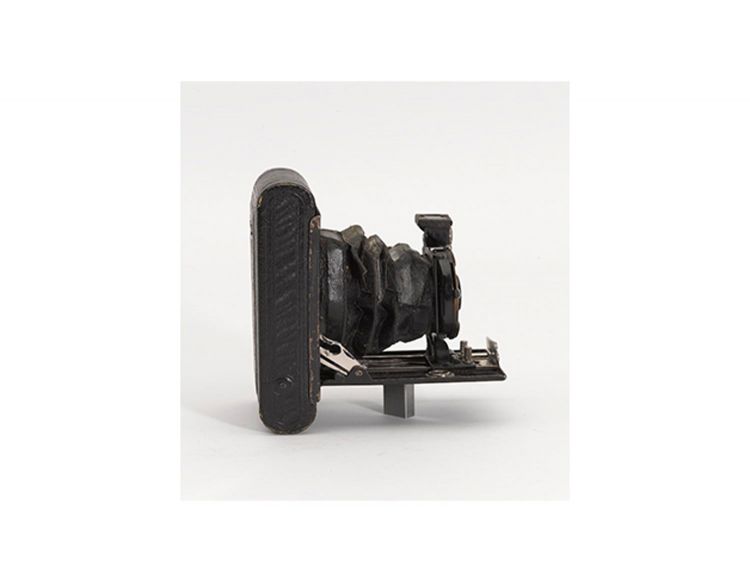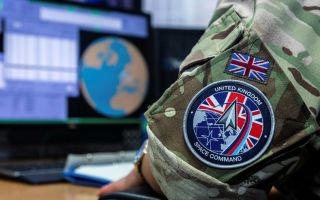Soldier's Stunning Second World War Album Discovered
Frank Tomlinson served with the 74th Field Regiment, Royal Artillery, between 1944 and 1946. An avid photographer, he documented his journey through war-torn Europe with pens, paper and a Kodak camera. His work, collected over a 2 year deployment captured the varied aspects to life on the front line during the Second World War. Frank’s illustrations shine a fascinating, new, and very personal light onto life behind enemy lines leading up to one of the most infamous allied operations of the war.
The National Army Museum acquired Frank's collection of over 1,000 photographs which were never before seen by the public, courtesy of his wife Nellie. Wanting to ensure the album would be kept safe, Nellie donated it to the museum on her late husband's behalf.
This is the famous Kodak Vest Pocket Model B, which used 127 film, and was sold as a current model from 1925-34. It was an updated version of the Kodak Vest Pocket Autographic, which had been used so heavily by soldiers during the First World War that it had been nicknamed the 'Soldier's Camera'. Frank Tomlinson may well have bought his Model B based upon this heritage and taken it to war again in 1944.
This page of the album contains a fascinating account of how Tomlinson put his album together, the innovative ways he found to develop the photographs en route and some of the conditions he faced that affected their outcome. It also mentions the units he served with, and then provides some statistics on the number of images taken and the time and cost to process them and assemble the album.
Tomlinson produced this hand-drawn map to outline the journey he and his units undertook during the liberation of Europe, following their war. It begins with their departure from Tilbury in England and sea passage to France, the landing in Normandy, and subsequent breakout. It then follows their journey through Belgium and into the Netherlands as part of Operation Market Garden, their eventual arrival in the Netherlands and diversion via Amsterdam, before heading into the Rhine Valley and crossing into Germany. Tomlinson labels the towns they passed through along the journey, and narrates the journey, noting he passed through 62 different locations before the war's end.
This is a photograph of the Restaurant Park Hotel Hartenstein in Oosterbeek, Netherlands, on the outskirts of Arnhem. A former villa, it was converted into a hotel in 1942, and during the Battle of Arnhem in September 1944 it was occupied as the headquarters of 1st Airborne Division as they attempted to seize and hold the bridge at Arnhem.
The purpose of Operation Market Garden was the seizure of the key river crossings over the Maas, Waal, and Lower Rhine Rivers in order to allow the Allies to break into Germany and shorten the war. Therefore every bridge that the Germans protected from capture, or worse demolished, would result in the Allied advance being slowed or even halted, putting the entire operation in jeopardy. Huge quantities of bridge building materials had been supplied in case of the need for rebuilding, along with 2,300 vehicles to transport it, and 9,000 engineers to repair or rebuild bridges.
Ironically, although the Bridge at Arnhem survived the battle, B-26 Marauders of the 344th Bomb Group bombed and destroyed it on 7 October 1944 to prevent the Germans from using it to send reinforcements south of the river. It was recaptured in April 1945, and a temporary Bailey Bridge erected alongside to provide a crossing whilst the main bridge was out.
A scene of wreckage amongst some trees in the aftermath of a battle. The vehicle is the famous American Willys MA-3 Jeep - a small four wheel drive utility vehicle that served as one of the workhorses of the Second World War with over 360,000 produced. It was light and fast, making it highly mobile, but had no armour, also making it highly vulnerable to attack.
A scene of countryside likely to be in the Low Countries with a typical Dutch-style tower windmill in the lower left. Squadrons of Waco, Airspeed Horsa or Hamilcar Gliders, packed full of troops and equipment, are being towed by C-47 Dakota Transports move overhead, likely en route to their insertions during Market Garden in September 1944. If you look closely enough between some of the pairs of aircraft, the tow cables can be seen. When near the designated landing zones, the gliders would be released from the aircraft towing them, and look to land as close and suffering as little damage as possible.
The wreckage of a General Aircraft Limited GAL. 49 Hamilcar "B5", registration number 277647, sits in a field where it has seemingly had a rough landing during insertion, as much of the tail section has come away from the frame. A soldier poses sitting on the wing, and another Hamilcar can be seen in the background.
A group of four British men pause in front of a mass war grave, having removed their caps in a solemn and contemplative moment. The grave is unmarked, but there are six berets present on and in front of the cross, and multiple floral tributes, indicating it is likely the grave of six men, probably of the 1st Airborne Brigade. Although obscured by trees, the building in the background looks very similar to the Hartenstein Hotel in Oosterbeek, part of the perimeter held by the British on the outskirts of Arnhem under intense German assault during the Battle of Arnhem.










